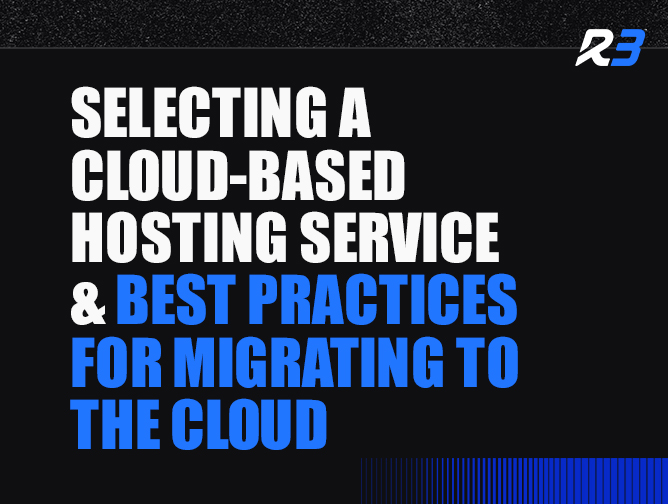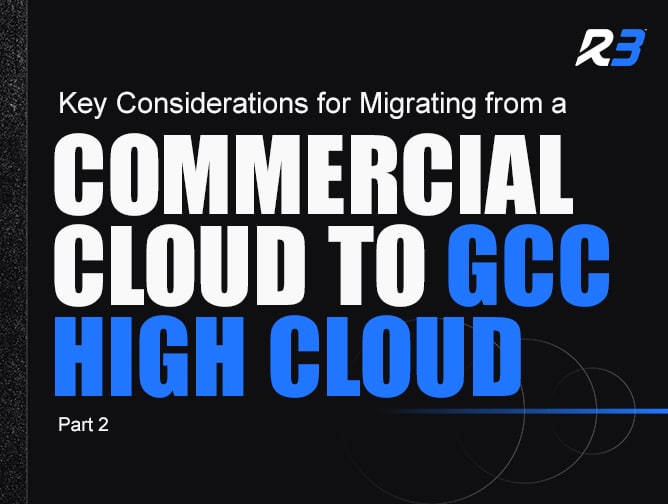Migrating a business to a cloud-based hosting service provides many benefits, including increased scalability, reliability, and security. However, the transition process can be complex and requires both technical and strategic expertise, so it is important to carefully plan and execute the move to ensure a smooth and successful transition.
In this post, we will provide a quick overview of; what a cloud-based hosting service is, the benefits of using a cloud-based hosting service, general best practices to consider when evaluating/migrating to a cloud-based hosting service, and a few recommendations of providers to consider to get you started in your evaluation process.
What is a cloud-based hosting service?
Cloud computing is the delivery of on-demand computing resources (hardware, storage, databases, networking, and software) to businesses and individuals via a network. The use of the cloud allows a business to manage and store its data without having to own or operate the physical space that the servers occupy. Basically, a cloud-based hosting service is when a website or application is hosted on virtual servers spread throughout a cloud network. Often just referred to as Cloud Computing, being on the cloud provides a level of scale, customization and flexibility that hadn’t existed before.
The National Institute of Standards and Technology defines cloud computing in five essential ways:
- On-demand self-service. A consumer can unilaterally provision computing capabilities, such as server time and network storage, as needed automatically without requiring human interaction with each service provider.
- Broad network access. Capabilities are available over the network and accessed through standard mechanisms that promote use by heterogeneous thin or thick client platforms (e.g., mobile phones, tablets, laptops, and workstations).
- Resource pooling. The provider’s computing resources are pooled to serve multiple consumers using a multi-tenant model, with different physical and virtual resources dynamically assigned and reassigned according to consumer demand.
- Rapid elasticity. Capabilities can be elastically provisioned and released, in some cases automatically, to scale rapidly outward and inward commensurate with demand. To the consumer, the capabilities available for provisioning often appear unlimited and can be appropriated in any quantity at any time.
- Measured service. Cloud systems automatically control and optimize resource use by leveraging a metering capability at some level of abstraction appropriate to the type of service (e.g., storage, processing, bandwidth, and active user accounts). Resource usage can be monitored, controlled, and reported, providing transparency for both the provider and consumer of the utilized service.
What is traditional web hosting?
The transition from traditional web hosting to cloud hosting began in the early 2000s. Traditional web hosting is when a website or application is conducted on a single server and most/all of a websites data/files/content is found on that server.
Traditional web hosting comes in four flavors; virtual private servers (VPS), dedicated, managed, and shared servers. The shared model of hosting is typically more economical as the general idea is that multiple organizations will share a single server and the cost to store data on it. A VPS is often known as a private cloud and functions as a virtual, isolated, environment on a single server. Using a VPS has more flexibility and control/customization for the organization utilizing it but it does have limitations in its ability to scale. However, VPS is the most similar to cloud-based hosting out of the traditional web hosting models. The last two traditional web hosting models, dedicated and managed servers, are very similar to one another; dedicated hosting is basically shared hosting but your organization doesn’t share the individual server and managed hosting is when your dedicated server is managed by the hosting provider (maintenance, security, various upgrades to hardware/software).
Benefits of using a cloud-based hosting service
- Scalability
With cloud computing its easy to add storage to fit your needs. It’s also pretty easy to lower your usage if you’ve over invested in storage space. Because you’re data is shared across a multitude of servers there is a ton of flexibility to scaleup or down with essentially the click of a button. - Performance improvements
Most cloud hosting providers rely on the most modern hardware and software to manage your data while also staying up-to-date on essential updates to keep everything moving smoothly. Additionally, servers are often regional so you can utilize local servers for improved performance. - Higher Reliability
In a cloud environment, if one server fails, another picks up the slack so that your business doesn’t become impacted by the aftermath of that failure. - Lower Costs
The flexibility of a cloud allows for more accurate pricing models. You can pay-as-you-go and use pricing models that are most appropriate for your company’s overall needs/usage. - Improved Security
Cloud based providers typically have multiple security layers that are highly advanced and complex, which a typical business might not have the capacity, bandwidth, budget, or expertise to develop themselves. Protecting your data is an essential value proposition for providers so you can typically rest assured that the best tools, best practices, and innovative strategies are being used. - Improved Collaboration
Operationally, the cloud allows for access to company data from anywhere with a reliable connection to the internet. As remote work becomes more prominent, the cloud is an essential tool to maintain operational efficiencies. - Reliable Backups
Most cloud providers will offer backup services and disaster recovery services in case of an emergency.
Best practices for evaluating cloud providers
Here are some steps to consider when transitioning a business to cloud-based hosting services:
- Assess your current infrastructure and needs.
Before making the move to the cloud, it is important to thoroughly assess your current infrastructure and identify your specific needs. This will help you to determine which cloud hosting options are the best fit for your business. - Select a cloud hosting provider.
There are many cloud hosting providers to choose from, each with their own unique features and pricing models. It is important to carefully research and compare different providers to find the one that best meets the needs of your business. Consider factors such as security, scalability, and customer support when making your decision. In the section below this one, we go over some general pros and cons of common cloud-based hosting providers. - Plan your migration strategy.
Once you have selected a cloud hosting provider, the next step is to plan your migration strategy. This may involve moving all of your systems to the cloud at once, or phasing the transition over time. It is important to carefully plan the migration to minimize disruption to your business operations. R3 manages multiple cloud migrations for clients of all shapes and sizes so feel free to reach out for a consultation. - Migrate your data and systems.
The actual process of migrating your data and systems to the cloud will depend on the specifics of your environment and the hosting provider you have chosen. It is important to work with your hosting provider to ensure that the migration is done smoothly and efficiently. - Test and validate the migration.
After the migration is complete, it is important to thoroughly test and validate that all systems and data are functioning as expected. This may involve conducting user acceptance testing and performing thorough system and data checks. - Train your employees.
Once the migration is complete, it is important to ensure that your employees are properly trained on how to use the cloud-based systems. This may involve providing training on new tools and processes, as well as updating policies and procedures. - Monitor and optimize performance.
After the transition is complete, it is important to monitor the performance of your cloud-based systems to ensure that they are meeting the needs of your business. This may involve regularly reviewing metrics such as uptime, response times, and resource usage, and making adjustments as needed to optimize performance.
Cloud-Based Hosting Providers to Evaluate
Microsoft Azure
Pros:
- Integration with Microsoft Products: Azure seamlessly integrates with Windows Server, Active Directory, and other Microsoft services.
- Hybrid Cloud Capability: Offers strong support for hybrid cloud environments, making it suitable for businesses with on-premises infrastructure.
- PaaS Offerings: Provides a wide range of platform-as-a-service offerings, simplifying application development.
- Comprehensive Compliance: Azure has extensive compliance certifications which can be beneficial for regulated industries.
- Global Data Center Presence: Azure has data centers in many regions, ensuring low-latency access for users worldwide.
If you’re considering moving into a GCC High environment, read this blog on GCC migration strategies.
Cons:
- Complex Pricing Structure: Azure’s pricing can be complex, and it may require careful monitoring to control costs effectively.
- Learning Curve: Getting started with Azure can be challenging for newcomers due to its extensive features and services.
- Limited Open-Source Support: Some open-source solutions may have better support on other cloud platforms.
- Occasional Downtime: Like any cloud service, Azure has experienced occasional service interruptions.
- Dependency on Microsoft Ecosystem: Azure’s strong integration with Microsoft products may be a limitation if your business relies on non-Microsoft technologies.
Amazon Web Services (AWS)
Pros:
- Market Leader: AWS is the market leader, offering a wide range of services and a large, mature ecosystem.
- Scalability: It provides unmatched scalability, allowing businesses to adapt to changing demands quickly.
- Strong Security Features: AWS offers robust security and compliance tools to protect data.
- Rich Ecosystem: It has a vast partner network and a large community, making it easy to find resources and expertise.
- Pay-as-You-Go Pricing: AWS’s pay-as-you-go pricing model offers flexibility and cost control.
Cons:
- Complexity: The sheer number of services and options can be overwhelming, especially for newcomers.
- Cost Management: While pay-as-you-go is a pro, it can lead to unexpected costs if not carefully monitored.
- Lack of Customer Support: Some users have reported issues with AWS customer support.
- Data Transfer Costs: Data transfer costs can add up, especially for large, data-intensive applications.
- Limited PaaS Offerings: AWS’s PaaS offerings are not as extensive as some competitors like Azure.
Oracle Cloud Infrastructure
Pros:
- Database Expertise: Oracle Cloud is known for its strong database services and expertise.
- High-Performance Computing: Offers high-performance computing instances suitable for data-intensive workloads.
- Enterprise Integration: Oracle Cloud integrates well with existing Oracle software and systems.
- Autonomous Database: Offers autonomous database services that require less management.
- Comprehensive Cloud Suite: Provides a broad set of cloud services, including IaaS, PaaS, and SaaS.
Cons:
- Narrower Ecosystem: Oracle’s ecosystem is not as extensive as AWS or Azure, limiting the range of available services.
- Pricing Complexity: Oracle’s pricing can be complex and may not always be as competitive as other cloud providers.
- Limited Regional Availability: It has a smaller number of data centers compared to AWS and Azure.
- Less Community Support: The community and resources for Oracle Cloud are not as extensive as some other providers.
- Vendor Lock-In: Strong integration with Oracle technologies may lead to vendor lock-in concerns.
Google Cloud Platform (GCP)
Pros:
- Data and Machine Learning: GCP is known for its strong data analytics and machine learning services.
- Big Data Capabilities: Offers big data services like BigQuery for data processing and analytics.
- Global Network: GCP has a fast and reliable global network, providing low-latency access to users.
- Open Source Support: It has good support for open-source technologies and communities.
- Pay-as-You-Go Pricing: Like AWS, GCP offers a flexible pay-as-you-go pricing model.
Cons:
- Smaller Market Share: GCP has a smaller market share compared to AWS and Azure, leading to fewer resources and partners.
- Fewer Services: While it has a wide range of services, it may not have as many options as AWS or Azure.
- Documentation and Learning Resources: Some users find GCP’s documentation and learning resources less comprehensive.
- Less Enterprise Experience: GCP may not be as enterprise-focused as some of its competitors.
- Pricing Complexity: Like other cloud providers, GCP’s pricing can be complex and require careful monitoring.
VMware Cloud
Pros:
- Compatibility with On-Premises Infrastructure: VMware Cloud is a popular choice for businesses looking to extend their existing VMware environments to the cloud.
- Familiar Tools and Interfaces: Users can leverage familiar VMware tools and interfaces.
- Migration Ease: Provides a seamless pathway for migrating on-premises workloads to the cloud.
- Resource Pooling: Allows organizations to pool resources efficiently and scale as needed.
- Security and Compliance: Offers strong security and compliance features.
Cons:
- Vendor Lock-In: Businesses heavily invested in VMware may face vendor lock-in concerns.
- Limited PaaS Offerings: VMware’s platform-as-a-service offerings are not as extensive as those of the major cloud providers.
- Scalability Challenges: May not be as well-suited for rapidly changing, highly-scalable workloads.
- Limited Native Cloud Services: VMware Cloud may lack some of the native cloud services available in other cloud providers.
- Potentially Higher Costs: Costs can be higher compared to some public cloud offerings, especially for small businesses.
IBM Cloud
Pros:
- Hybrid Cloud Focus: IBM Cloud offers a strong focus on hybrid cloud solutions, making it suitable for businesses with on-premises infrastructure.
- AI and Watson Services: IBM Cloud provides strong AI and machine learning services.
- Global Network: It has a robust global network for low-latency access to users.
- Industry-Specific Solutions: Offers industry-specific solutions and compliance for regulated industries.
- PaaS and Developer Tools: Provides a range of platform-as-a-service and developer tools.
Cons:
- Market Share: IBM Cloud has a smaller market share compared to AWS, Azure, and GCP.
- Complex Pricing: Pricing can be complex, and businesses may need to carefully manage costs.
- Fewer Services: It may not offer as many services and options as larger cloud providers.
- Limited Community: The user community and available resources may be smaller.
- Integration Challenges: Integration with non-IBM technologies can be more challenging.
To sum it all up, migrating a business to cloud-based hosting services can bring many benefits, but it is a complex process that requires careful planning and execution. By following the steps outlines above, businesses can ensure a smooth and successful transition to the cloud.
Remember, R3 is your reliable partner and as you consider migrating to a cloud-based hosting provider, our IT Projects team is always here for a quick call to provide you with some advice and general insights.







